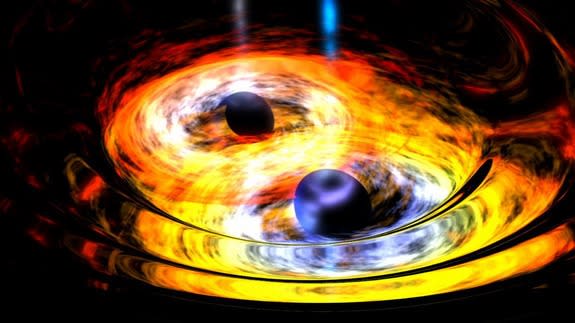Gravitational waves mark start of new era in space exploration

On Feb. 11, scientists announced the discovery of gravitational waves, ripples in the fabric of space and time produced by the collision of two black holes about 30 times more massive than the sun. This discovery ushers in a new era in human understanding of our place in the universe.
For a brief second as they collided, the black holes produced 50 times the energy of all the stars in the observable universe combined, according to researchers involved in the large international collaboration that uncovered the new findings.
The Laser Interferometer Gravitational-Wave Observatory (LIGO) instruments in Washington and Louisiana caught sight of the build-up to and the moment when the black holes merged into one, which occurred about 1.3 billion years ago.
SEE ALSO: Einstein was right: Scientists detect gravitational waves for the first time
The sighting verifies the existence of the elusive space waves and validates one of Albert Einstein's 100-year-old predictions.
This, perhaps more than anything else, is a fitting beginning for a new age in astrophysics.
The next step
"We can observe the universe in this new way; not using light, but using gravity," physicist Brian Greene told Mashable in an interview.
As one LIGO scientist pointed out, the discovery is akin to astrophysicists gaining a new sense: hearing.
"Now we set to work to use that tool to examine astrophysical phenomena: the merger of black holes, the motion of neutron stars, the formation of massive black holes, the nature of space and time. All of that now is open to us in a sparkling new way."

Image: LIGO/SXS/R. Hurt and T. Pyle
Before this discovery, researchers explored the universe using infrared, ultraviolet and visible light, with optical and radio telescopes, but now they have a new way to probe the depths of the cosmos: by using gravity as a way to observe what would otherwise be invisible.
It's as if astronomers suddenly gained a new sense: hearing, and there's no telling how many discoveries this will lead to.
Gravitational waves propagate through space-time, the malleable structure that surrounds cosmic objects like planets, stars and black holes.
“Everything that happens in the universe — a bit of light traveling from one place to another, or mass moving around — that’s happening in space-time, and it’s affecting space-time and it’s being affected by space-time," astrophysicist Katie Mack said.
Understanding the universe's extremes
Ripples in space-time can be produced by destructive events like the collision of two massive objects like black holes and neutron stars. And studying gravitational waves could fundamentally change the way humans learn more about these extreme objects in the universe.
By researching black holes — massive warps in space-time thought to form from the collapse of huge, dying stars — using gravitational wave science, for example, researchers may be able figure out the fates of some of the first stars that formed after the Big Bang, LIGO scientist Matthew Evans said.
In fact, the black holes thought to produce the gravitational waves detected by LIGO may have "come from some of the first stars that were created in the universe," Evans said.
"Black holes are kind of like the dinosaur bones of the universe, so in some sense, we can do something like stellar archaeology and look at the history of the universe through the products of these large stars."
Researchers may now be able to take a census of the universe to discover how many black holes there are out in space, and gravitational wave data will likely be used to learn more about how pairs of merging black holes form.
Video: Nadja Oertelt, Quincy Ledbetter
While scientists think they have a sense of how black holes form, they aren't sure how two of them come to orbit one another in binary pairs. Scientists think either binary black holes were formed from a double star system or they are "completely solitary" black holes that end up in a star cluster orbiting one another, LIGO researcher Nergis Mavalvala said.
By studying the spin of the black holes, which is now possible with LIGO, it should give scientists some clues about how these binary pairs come to be, Mavalvala added.
This kind of research isn't just limited to black holes.
Scientists still want to investigate the nature of mysterious objects known as neutron stars — extremely massive yet very tiny stars that represent the remnants of a star that has gone supernova.
LIGO is sensitive enough to pick up the gravitational wave signatures of two neutron stars colliding, possibly leading astronomers to clues about the nature of those mysterious objects.
New technology for new discoveries
LIGO's detection could also lead to new, even more sensitive tools that could detect the gravitational waves sent out by other cosmic crashes of various origins.
And not all gravitational wave science needs to happen on Earth.
The European Space Agency (ESA) recently launched the LISA Pathfinder mission as a testbed for technology capable of detecting gravitational waves from space.
In the 2020s, the ESA is planning to launch a full-scale version of LISA called eLISA to map space-time's ripples.
Even LIGO itself should get more sensitive as its lifetime progresses, project scientists said on Feb. 11.
Scientists think they may have even detected other, fainter signals from gravitational waves with LIGO, but the instrument's sensitivity isn't yet high enough to be sure that those readings are signals, rather than noise.
In the future, once LIGO reaches its peak sensitivity, it should allow scientists to "hear" other gravitational waves as they pass through Earth.
But aside from the known questions scientists want answered, many of them are also excited about the unknowns yet to be asked.
"Every time we've pointed a new telescope in the sky, we’ve seen things we didn’t expect. That’s just how the universe is," Mavalvala said.

